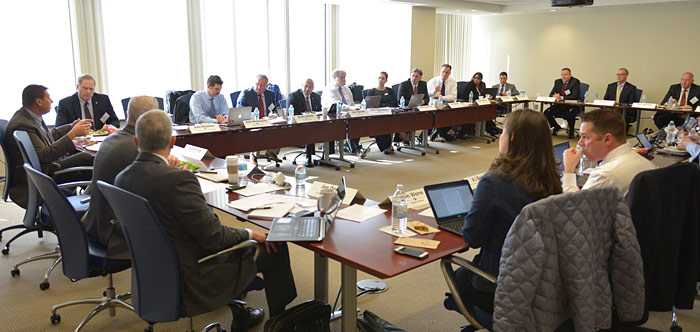Aviation Jumpseat
By Capt. Rich Odbert (FedEx Express), Air Safety Organization Aviation Jumpseat Chairman

The Jumpseat Committee convenes to discuss security developments and improvements that affect all airline pilots.
Integrating the Aviation Jumpseat Group into the Air Safety Organization (ASO) is a clear validation of the group’s dual mission: enhancing safety and security by providing access to the cockpit jumpseat to qualified crewmembers and defending pilot-in-command (PIC) authority over flight deck access by ensuring that use of the jumpseat isn’t abrogated or undermined in any manner or under any circumstances.
Section 85 of ALPA’s Administrative Manual details the roles and responsibilities of the group, and—like the other pillars of the ASO—we collaboratively interact with master executive council representatives on the Jumpseat Council. Together, we work to maintain the industry lead for all things related to flight deck access to the jumpseat.
In the post-9/11 world, we’ve been proactive in ensuring that our flight decks are protected and that regulations allow access to authorized personnel. As just one example, a 2009 ALPA white paper on flight deck safety and security was instrumental in helping to lift a prohibition against off-line jumpseaters riding the cockpit jumpseat.
However, we continue to learn of instances in which individuals deviate from FAA regulations and guidance when allowing access to the jumpseat, which can compromise safety and security. Compounding the problem are the uncoordinated actions of some airline managements, which include allowing less-restrictive language than required in flight operations manuals. This is viewed in the industry as a threat to other pilots and is having a negative effect on PIC authority, forcing pilots to deny rather than approve jumpseat requests, which threatens reciprocal access.
In Canada, we’re actively supporting the development of CAN–CASS (i.e., Canadian Cockpit Access Security System) for the country’s airline pilots. Ideally, this should lead to the eventual reintroduction of Canadian pilots onto U.S. flight decks, something our regulations currently prohibit.
We’re also developing international flight deck access among U.S. flag carriers for use by off-line pilots. We’ve coordinated with the Transportation Security Administration (TSA) and Customs and Border Protection on this initiative. TSA policy supports this ALPA project, and both agencies have the capability to vet individuals in real time, which makes it feasible. We’re presently working with numerous airlines that are in the process of establishing the IT capabilities to make this a reality on their respective properties. All parties continue to recognize additional pilots on board as safety and security assets.
This collaborative effort—as with CASS and Known Crewmember in the past—is in the best interests of ALPA pilots and all airlines. The support we’ve received from, and given to, the International Federation of Air Line Pilots’ Associations, non-ALPA pilot groups, and other organizations is a testament to the game changer this program will become.
Making it easier for pilots to be informed about jumpseat access and users is also very important. ALPA’s jumpseatinfo.org website recently was overhauled and rebranded to closely match ALPA’s main website. Through the approval of ALPA leaders, non-ALPA pilot representatives received permission to access the site to share and self-police flight deck access use and abuses—which can be challenging as information and policies are continuously changing. In addition to enhancing the jumpseat website, we’ve also been heavily involved in improving the jumpseat information provided on ALPA’s smartphone app.
We’re also working to improve the education and awareness of others when it comes to accessing the jumpseat. The abuses we do see are often traced back to gate agents, individual screeners, and on rare occasions authorized users who are unfamiliar with the rules or reciprocal protocols of access agreements.
Our installation as a fourth pillar of the ASO not only strengthens the Aviation Jumpseat Group’s importance to safety and security, but also boosts its role when ALPA works with government and industry stakeholders. We continue to foster strong relationships with other pilot unions and the FAA, the TSA, and Customs and Border Protection. And, as always, ALPA’s Engineering & Air Safety Department continues to make valuable contributions in supporting the group.
A PIC’s control of the jumpseat and flight deck is his or her right and responsibility, and the use of it by other pilots is a privilege. It’s something that we must, and will always, defend.

